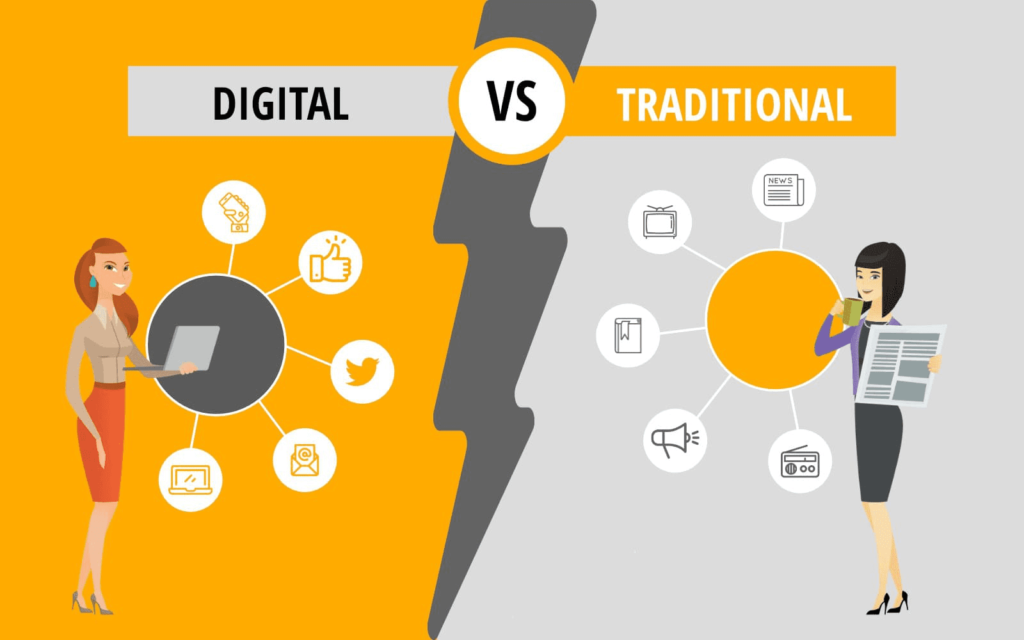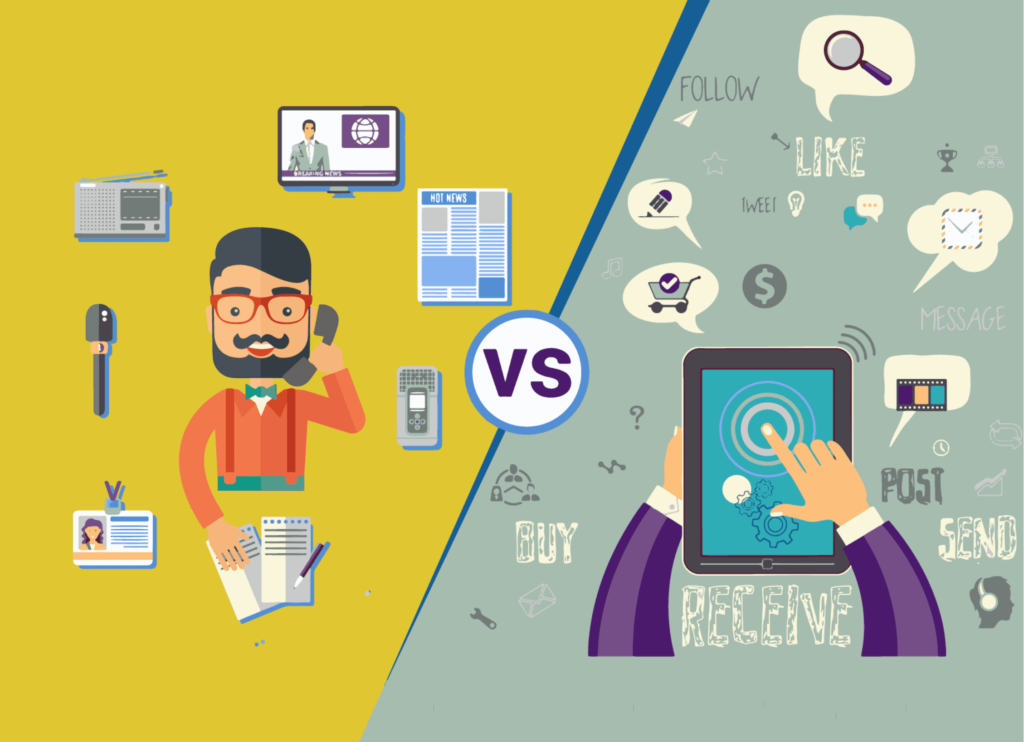Digital Marketing VS Traditional Marketing
The evolution of technology has propelled both avenues, yet understanding their distinctions and leveraging their strengths can significantly impact a company’s success.

Digital Marketing Channel vs. Traditional Marketing Channel:
Exploring the Key Differences and Benefits
In the dynamic landscape of marketing, the clash between digital marketing channels and traditional methods continues to shape how businesses engage with their audience. The evolution of technology has propelled both avenues, yet understanding their distinctions and leveraging their strengths can significantly impact a company’s success.
Understanding Digital Marketing
Digital marketing encompasses various online strategies aimed at reaching and engaging with target audiences. From social media and content marketing to email campaigns and search engine optimization (SEO), this realm offers unparalleled avenues for businesses to connect with their customers.
One of the standout advantages of digital marketing lies in its ability to precisely target specific demographics. Through tools like Google Analytics and Facebook Insights, marketers gain valuable insights into consumer behavior, enabling tailored and personalized campaigns.
The Power of Traditional Marketing
Contrastingly, traditional marketing comprises conventional methods such as print ads, television commercials, billboards, and radio spots. While these avenues lack the granular targeting capabilities of their digital counterparts, they possess unique strengths.
One such strength is the potential for a broader reach within a local community. A strategically placed billboard or a well-crafted newspaper ad can capture the attention of a diverse audience, including those less inclined towards digital platforms.
Key Differences and Benefits
Cost-Effectiveness
Digital marketing often proves more cost-effective than traditional methods. Online campaigns allow for precise budget allocation, ensuring that resources are channeled where they yield the most significant impact. Moreover, the ability to track and analyze metrics in real-time enables quick adjustments, optimizing the return on investment (ROI).
Traditional marketing, though, can require substantial financial commitments, especially for large-scale endeavors like TV commercials or print ads in high-circulation publications. However, it can yield favorable results by reaching audiences who may not actively engage with online platforms.
Engagement and Interaction
Digital channels excel in fostering engagement and interaction. Platforms like social media facilitate direct communication between brands and consumers, fostering a sense of community and loyalty. Interactive content such as quizzes, polls, and live sessions enhance user engagement, nurturing stronger relationships.
On the other hand, traditional marketing often operates as a one-way communication channel. While impactful and creative, it lacks the interactive element that characterizes digital strategies. However, well-executed campaigns can leave a lasting impression through memorable visuals or catchy jingles.
The Evolving Landscape
The marketing landscape continues to evolve, and a blend of both digital and traditional approaches can often yield the most effective results. Integrating digital strategies with traditional methods allows businesses to maximize their reach while maintaining personal connections with their audience.

Understanding Digital Marketing Channels and Their Impact
In the digital era, marketing strategies have shifted significantly, with businesses leveraging various online platforms and technologies to connect with their audience. These digital marketing channels play a pivotal role in reaching, engaging, and converting customers. Let’s explore some key digital channels transforming the marketing landscape.
1. Social Media Marketing (SMM)
Social media platforms like Facebook, Instagram, Twitter, LinkedIn, and TikTok have become vital for businesses to engage with their audience. SMM involves creating and sharing content, running ads, and interacting with users to build brand awareness, foster relationships, and drive conversions. These platforms offer sophisticated targeting options, allowing businesses to tailor messages to specific demographics, interests, and behaviors.
2. Search Engine Optimization (SEO)
SEO is the practice of optimizing websites to improve visibility and ranking on search engine results pages (SERPs). By strategically using keywords, creating high-quality content, improving website structure, and enhancing user experience, businesses aim to attract organic (unpaid) traffic from search engines like Google, Bing, and Yahoo. Higher rankings can significantly increase website visibility and traffic, leading to more opportunities for conversions.
3. Content Marketing
Content marketing revolves around creating and distributing valuable, relevant, and consistent content to attract and retain a clearly defined audience. Content can take various forms, including blog posts, articles, videos, infographics, eBooks, and podcasts. The goal is to provide value to the audience, establish authority, and drive profitable actions. Quality content not only engages users but also aids in SEO efforts and builds brand credibility.
4. Email Marketing
Despite being one of the oldest digital marketing channels, email marketing remains a powerful tool for nurturing leads, retaining customers, and driving conversions. Through personalized and targeted emails, businesses can deliver relevant content, promotional offers, updates, and newsletters directly to subscribers’ inboxes. Email marketing automation further streamlines communication and enables businesses to maintain consistent engagement with their audience.
5. Pay-Per-Click Advertising (PPC)
PPC advertising involves paying a fee each time a user clicks on an ad. Platforms like Google Ads, Bing Ads, and social media ad platforms offer PPC options that allow businesses to display ads to targeted audiences. These ads appear prominently in search engine results or within social media feeds, contributing to increased visibility, website traffic, and conversions. Effective PPC campaigns rely on strategic keyword selection, compelling ad copy, and optimized landing pages.
6. Influencer Marketing
Influencer marketing capitalizes on individuals with a strong online presence and a dedicated following. Brands collaborate with influencers to promote their products or services to their audience. Influencers’ authenticity and rapport with their followers often result in higher engagement and trust, leading to increased brand awareness and conversions.
7. Affiliate Marketing
Affiliate marketing involves partnering with individuals or other businesses (affiliates) who promote a company’s products or services in exchange for a commission for each sale or action generated through their referral link. It’s a performance-based marketing strategy where affiliates are incentivized to drive conversions, benefiting both parties involved.
8. Mobile Marketing
With the widespread use of smartphones, mobile marketing focuses on reaching users through mobile devices. This includes strategies like mobile-optimized websites, mobile apps, SMS marketing, and location-based marketing. Leveraging mobile channels allows businesses to connect with users in real-time, providing personalized experiences and driving engagement.
The Impact of Digital Marketing Channels
These digital marketing channels offer several advantages that traditional marketing methods often can’t match:
- Targeted Reach: Precise audience targeting leads to higher relevance and engagement.
- Measurable Results: Detailed analytics provide insights into campaign performance, allowing for data-driven decision-making.
- Cost-Effectiveness: Many digital channels offer scalable solutions, making them accessible to businesses of all sizes.
- Global Reach: With the internet’s global nature, businesses can reach audiences worldwide, breaking geographical barriers.

Exploring Traditional Marketing Channels: Strategies and Impact
In the digital age, traditional marketing channels still hold relevance in reaching audiences and promoting products or services. These time-tested methods continue to play a crucial role in marketing strategies. Let’s delve into some key traditional marketing channels that have shaped the marketing landscape.
1. Television Advertising
Television commercials remain a prominent marketing channel, offering businesses the opportunity to reach a vast audience. Advertisements aired during popular TV shows, events, or sports programs enable brands to create compelling visual narratives that resonate with viewers. While it’s a more expensive avenue compared to digital channels, TV advertising allows for broad reach and exposure.
2. Print Media
Print media encompasses advertising through newspapers, magazines, brochures, flyers, and other physical publications. These mediums have a tangible presence, offering a lasting impression and targeting specific demographics based on publication readership. Print ads allow for creative and visually appealing layouts, offering businesses flexibility in design and message delivery.
3. Radio Advertising
Radio advertising continues to be an effective way to reach local and niche audiences. It allows for targeted messaging and is often more cost-effective compared to TV advertising. With catchy jingles, engaging scripts, and precise targeting based on time slots and audience demographics, radio ads can effectively capture listeners’ attention.
4. Outdoor Advertising
Billboards, posters, banners, and other outdoor advertising methods are strategically placed in high-traffic areas to maximize visibility. They create brand awareness and convey messages to a broad audience. These visual displays capitalize on commuters, pedestrians, and motorists, making a lasting impression due to their physical presence.
5. Direct Mail Marketing
Direct mail involves sending physical promotional materials such as postcards, catalogs, flyers, and brochures directly to consumers’ mailboxes. While it may seem outdated, direct mail marketing can be highly targeted, allowing businesses to reach specific households or demographics. Personalized mail can also create a tangible connection with recipients.
6. Telemarketing
Telemarketing involves businesses reaching out to potential customers via phone calls to promote products or services. While it has faced some challenges due to consumer preferences and regulations, telemarketing remains a direct and interactive method to engage with prospects. Personalized conversations can convey detailed information and address queries in real-time.
7. Events and Sponsorships
Participating in events or sponsoring them allows brands to engage with audiences in person. This could range from trade shows, conferences, sports events, or local community gatherings. Through booths, presentations, or sponsorships, businesses can interact directly with potential customers, build brand loyalty, and create memorable experiences.
The Impact of Traditional Marketing Channels
Traditional marketing channels offer several advantages that complement digital strategies:
- Mass Reach: These methods have historically reached large audiences, especially before the internet’s prevalence.
- Tangible Presence: Physical advertisements create a lasting impression and hold value through their physicality.
- Localized Targeting: Some traditional channels allow for precise targeting based on local demographics or readership.
- Established Credibility: Established publications or TV networks may offer a sense of credibility due to their longstanding presence.



Magnificent beat I would like to apprentice while you amend your site how can i subscribe for a blog web site The account helped me a acceptable deal I had been a little bit acquainted of this your broadcast offered bright clear idea
Thanks for reading our blog.